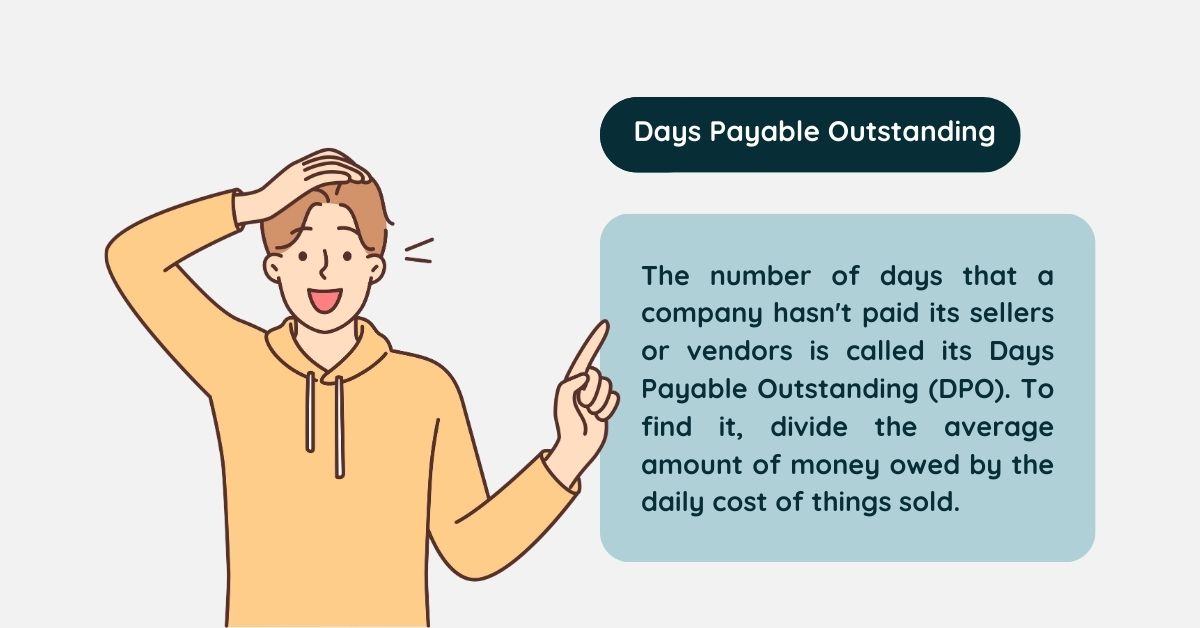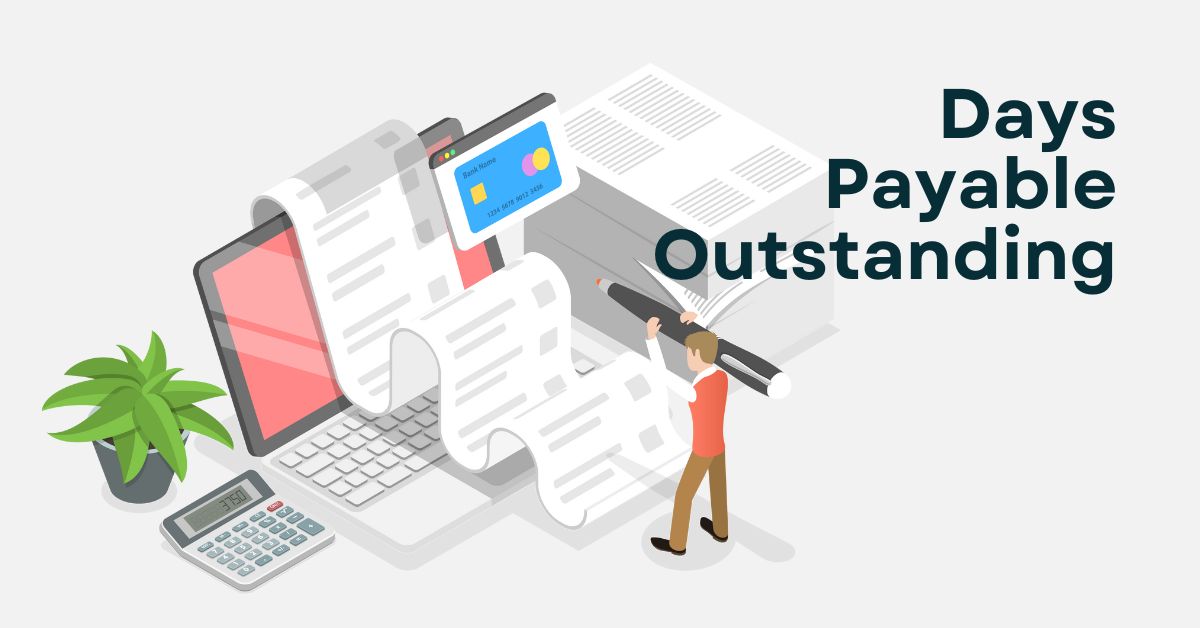Days Payable Outstanding (DPO) is a complicated measure used in financial management to show how quickly a company pays its suppliers. By looking at DPO, companies can learn more about their cash flow, improve their payment terms, and build stronger relationships with their suppliers.
What is Days Payable Outstanding?

The number of days that a company hasn’t paid its sellers or vendors is called its Days Payable Outstanding (DPO). To find it, divide the average amount of money owed by the daily cost of things sold.
A bigger DPO means that the company is taking longer to pay its bills, which could hurt its creditworthiness and put pressure on its relationships with its suppliers. On the other hand, a lower DPO means that the company pays its suppliers on time, which can help its image and give it more negotiating power.
Formula of Days Payable Outstanding
The formula for Days Payable Outstanding (DPO) is:
DPO = (Average Accounts Payable / Cost of Goods Sold) * Number of Days in Period
Here’s a breakdown of the components:
- Average Accounts Payable: This is the average amount of money a company owes to its suppliers over a specific period (often a year).
- Cost of Goods Sold (COGS): There are direct costs that come up when a company makes and sells things or services.
- Number of Days in Period: This is the number of days in the period for which you are calculating DPO (usually 365 for a year).
You can tell how well a company is handling its cash flow and accounts payable by figuring out its DPO. It takes longer for a company to pay its suppliers when the DPO is high. On the other hand, it pays its suppliers quickly when the DPO is low.
When is a High or Low DPO Indicated?
A high DPO can be beneficial because it means that a company is handling its cash flow well by putting off paying its suppliers. This can free up money that can be used for other things, like investments or running the business. A very high DPO, on the other hand, can hurt ties with suppliers and might make it harder to get credit in the future.
A low DPO, on the other hand, means that a company pays its suppliers on time. This can help you get along better with your suppliers, which could lead to better terms or savings. A very low DPO, on the other hand, could mean that the company isn’t making the most of the credit it has access to and is missing out on chances to spend its cash more wisely.
In the end, the best DPO level relies on things like the norms in the industry, the relationships with suppliers, and the overall financial strategy of the company. To get useful information, you should compare a company’s DPO to averages in the same business and look at it along with other financial metrics.
Importance of Days Payable Outstanding
Days Payable Outstanding (DPO) is a crucial financial metric that offers valuable insights into a company’s financial health and operational efficiency. Here’s why DPO is important:
Cash Flow Management:
- Increased Cash Flow: When a business’s DPO is higher, it takes longer to pay its suppliers. This lets the company keep its cash for longer, which improves its cash flow.
- Reduced Interest Expenses: By delaying payments, companies can potentially reduce interest expenses on loans or lines of credit.
Supplier Relationships:
- Improved Negotiating Power: A higher DPO can give a company more negotiating power with suppliers, as it demonstrates financial strength and the ability to delay payments.
- Potential for Discounts: Prompt payment discounts offered by suppliers can be strategically utilized to further optimize cash flow.
Financial Health Assessment:
- Indicator of Liquidity: A high DPO can signal strong liquidity, as the company has sufficient cash to meet its obligations.
- Benchmarking: Comparing DPO to industry standards helps assess a company’s performance relative to its peers.
Operational Efficiency:
- Payment Process Optimization: Analyzing DPO can identify inefficiencies in the accounts payable process and lead to improvements.
- Automation Opportunities: Identifying areas for automation can streamline payment processes and reduce errors.
A bigger DPO can be good, but it’s important to keep things in balance. A DPO that is too high can hurt the company’s creditworthiness and put a strain on its ties with suppliers. So, keeping an eye on DPO and making smart choices about when to make payments are essential for good money management.
Differences Between DPO and Other Cash Flow Measures?
| Measure | Definition | Focus | Implication |
|---|---|---|---|
| Days Payable Outstanding (DPO) | Average number of days a company takes to pay its suppliers’ invoices. | Payables Management | High DPO = More cash on hand, but potential for strained supplier relationships. |
| Days Sales Outstanding (DSO) | Average number of days it takes a company to collect payment from customers after a sale. | Receivables Management | Low DSO = Faster cash inflow, improved liquidity. |
| Cash Conversion Cycle (CCC) | The amount of time it takes for a business to get cash flows from its investments in goods and other working capital. | Overall Efficiency | Lower CCC = Faster cash conversion, improved liquidity. |
| Operating Cash Flow (OCF) | Cash generated or used by a company’s ongoing operations. | Operating Performance | Positive OCF = Strong operational performance, ability to generate cash. |
| Free Cash Flow (FCF) | Cash generated by a company after accounting for capital expenditures. | Financial Flexibility | Positive FCF = Ability to pay dividends, reduce debt, invest in growth. |
How to Improve DPO?
To improve DPO, companies can implement several strategies:
- Negotiate favorable payment terms with suppliers: Aim for longer payment terms to extend the time it takes to pay invoices. This can be achieved through strong relationships, volume discounts, or strategic bargaining.
- Optimize payment processes: Streamline the accounts payable process by automating tasks like invoice processing, approval workflows, and payment disbursements. This reduces manual errors and delays, allowing for timely but strategic payments.
- Centralize payment functions: Consolidate payment activities to gain better control over cash flow and payment timing. This can involve centralizing the AP department or using centralized payment systems.
- Implement a centralized payment calendar: Create a schedule for payments, prioritizing critical suppliers or those offering early payment discounts. This ensures timely payments while maximizing the float period.
- Monitor and analyze DPO regularly: Track DPO metrics to identify areas for improvement. Analyze payment patterns, supplier performance, and the impact of different payment strategies.
- Consider early payment discounts: Evaluate the cost-benefit of taking advantage of early payment discounts. If the discount exceeds the cost of early payment, it may be beneficial to pay suppliers sooner.
Remember that a higher DPO can help your cash flow, but it’s important to keep positive ties with your suppliers at the same time. Don’t be too slow with your payments; that could hurt these ties.
Pros and Cons of DPO
What Does Days Payable Outstanding Mean in Accounting?
Days Payable Outstanding (DPO) is a financial term that shows how long it usually takes for a business to pay its bills. It basically shows how well a business handles its accounts payable. A higher DPO means that the business pays its bills more slowly, while a smaller DPO means that it pays its bills more quickly.
DPO is a useful way to check how well a business handles its cash flow and works with its providers. It’s possible for a higher DPO to give the business more time to use its cash for other things, but it’s important to keep positive relationships with suppliers and avoid penalties or credit problems.
What Is the Difference Between DPO and DSO?
| Feature | Days Payable Outstanding (DPO) | Days Sales Outstanding (DSO) |
|---|---|---|
| Focus | How long a company takes to pay its suppliers | How long a company takes to collect payment from customers |
| Impact on Cash Flow | Higher DPO can improve cash flow by delaying payments to suppliers | Lower DSO can improve cash flow by accelerating collections from customers |
| Ideal Trend | Generally, a higher DPO is better (within reason) | Generally, a lower DSO is better |
| Relationship to Financial Health | A high DPO can indicate efficient cash management, but excessive delays can strain supplier relationships | A high DSO can signal inefficient credit management and potential cash flow problems |
| Impact on Working Capital | Higher DPO can reduce working capital needs | Lower DSO can reduce working capital needs |
What is a Good Days Payable Outstanding?
A “good” DPO isn’t a set number; it depends on the business, the size of the company, and its relationships with its suppliers. However, a higher DPO usually means that the company is better at managing its cash flow because it takes longer to pay its providers, which lets it keep its cash for longer.
A DPO that is too high, on the other hand, can put pressure on relationships with suppliers and could lead to fines or supply problems. Because of this, it’s important to find a balance between having a higher DPO and keeping good ties with suppliers and making sure payments are made on time.
One that improves cash flow without hurting relationships with suppliers is called a “good” DPO.
Is It Better to Have a High or Low Days Payable Outstanding?
A higher DPO is usually thought to be better, but it’s not always the case.
When a company’s DPO is larger, it takes longer to pay its suppliers, which means it has more cash on hand. You can invest this extra money, pay off debt, or use it for other smart things. But it’s important to stay away from DPOs that are too high, as they can hurt ties with suppliers, hurt the company’s creditworthiness, and even cause legal problems.
The best DPO depends on the type of business, its size, and its ties with suppliers. Finding the right mix is important: you want to increase cash flow without hurting your relationships with suppliers or spending a lot of money.

